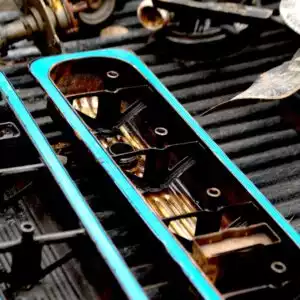Your vehicle’s head gasket is in charge of sealing your engine’s combustion chambers, preventing compression loss, as well as sealing passages that pass from the block into the head to prevent coolant and oil migration.
Head gaskets have several different failure modes, and head gasket sealer can’t help with some of the several ways head gaskets fail.
Failures head gasket sealer can help with are as follows:
- Coolant that enters the combustion chamber and temporarily fouls one or more spark plugs when starting the engine after a “hot soak.” This coolant disappears out the tailpipe while the engine is running.
- Combustion that enters the coolant and causes overheating and very high pressure.
The failures head gasket sealer can NOT help with are as follows:
- A leak from between the head and the engine block
- A combustion leak from one cylinder to an adjacent cylinder
- A leak that mixes oil and coolant (rare)
When you suspect that your head gasket is compromised, you’ll need to bring your vehicle to a trusted mechanic for a proper diagnosis because it’s easy to misdiagnose something else and blame it on the head gasket. If you’re a sharp enough DIY person to replace the head gasket on your own, feel free to proceed with caution. But for a quick head gasket patch in emergency cases, you might be able to postpone the inevitable with some head gasket sealer.
Usually, head gasket sealers require that the coolant needs to be completely drained and the cooling system needs to be filled with distilled water, displacing some of the water with the head gasket sealer liquid.
Then you’ll be instructed to run the engine for a certain amount of time, after which you let it cool down for several hours, and you drain the cooling system once more and refill with the 50/50 coolant mix.
How Does Head Gasket Sealer Work
Head gasket sealer is a substance made specifically for sealing up cracks on the head gasket. These cracks typically form between the engine block and the cylinder head. Because it closes any potential leaks, this type of head gasket seal allows you to continue driving your vehicle even with a damaged head gasket.
Products that seal a blown head gasket while the engine is running use chemicals that react with the combustion chamber heat and pressure to form a solid seal at the leak point. Again, these only work where the combustion chamber meets the water jacket. They won’t fix any other type of head gasket leak.
How long this fix will last depends on the type of sealer you use. There are temporary and permanent head gasket sealers on the market, most of which are made out of a mix of epoxy and different chemicals. Epoxy is an excellent choice of material for this job because it doesn’t dry up when exposed to the engine’s high temperatures. Temporary sealers last for a certain number of miles or months depending on the brand while permanent sealers can last for years.
Products that seal a blown head gasket while the engine is running use chemicals that react with the combustion chamber heat and pressure to form a solid seal at the leak point. Again, these only work where the combustion chamber meets the water jacket. They won’t fix any other type of head gasket leak.
–Richard McCuistian, ASE Certified Master Automobile Technician
How To Use Head Gasket Sealer
When using head gasket sealer, it’s best to follow the instructions on the packaging. Here are a few tips and tricks to make the process smoother, but check the instructions that come with the product to make sure you’re doing it right.
- Gather your materials ahead of time to avoid scrambling for them while working.
- Lift your vehicle on a jack to make it easier to drain the coolant from your radiator.
- Add water to the radiator.
- Remove your thermostat before using the head gasket sealer to avoid getting sealer on it.
- Turn on your vehicle and its heater to circulate the water and drain any remaining coolant. Drain the water as well in this step.
- Add a fresh coolant-water mixture little by little until you reach capacity.
- Slowly add the gasket sealer.
- Drive your vehicle around for 30 minutes to let the sealer spread through the vehicle. Allow it to sit unused for two to three hours afterwards.
- You can reinstall the thermostat once the sealant in the head gasket sealer is activated.

Head Gasket Sealer Benefits and Drawbacks
There are a number of benefits and drawbacks to using head gasket sealer.
Benefits
Head gasket sealers are generally easy to use and DIY-friendly. You don’t need to remove your engine from your vehicle when applying it, saving you a lot of time. They’re also fairly affordable, especially compared to a brand new engine. Head gasket sealers can be used to fix oil leaks in a pinch as well.
Drawbacks
Head gasket sealers, even permanent ones, are still only a temporary solution. It’s always best to have a trusted mechanic take care of your vehicle’s head gasket as soon as possible if it’s leaking. After all, using a head gasket sealer isn’t quite as reliable as having a new gasket. Some variants of head gasket sealer also don’t work for very long. It’s difficult to tell which of the variants on store shelves are good and which ones are bad.
How To Identify a Leaking Head Gasket
When your head gasket springs a leak, you’ll likely want to reach for some head gasket sealer. But what can tip you off to a leaking head gasket in the first place?
Well, for starters, you might notice your engine misfiring. Your vehicle will jerk about during acceleration in this case. Leaking head gaskets also lead to burning coolant as it leaks out, resulting in white smoke from your exhaust. The loss of coolant will also lead to cooling system issues and your vehicle overheating. These symptoms accompany other issues, but a blown head gasket is worth investigating if a number of them happen at the same time.
Common Causes Behind Leaking Head Gaskets
Of course, you’ll want to avoid having a leaking head gasket in the first place. Here are two common causes behind your leaking head gasket:
Overheating
Overheating can lead to the cylinder head and other metal engine parts warping, which in turn can tear the head gasket and cause a leak. To combat this, keep your vehicle’s cooling system well-maintained, and try to pull over as soon as you notice your vehicle suddenly heating up as you drive.
Aluminum Components
Certain engines are more prone to warped head gaskets. These engines often come equipped with aluminum block heads. Because aluminum alloys are more sensitive to changes in temperature, they expand and contract much more than traditional cast iron. Gasket punctures occur when the clamping force is low when the temperature is colder, so try to warm your engine up before driving if you can.
Now you know how to seal a head gasket leak with some sealer. While it does work, remember that head gasket sealer is only a temporary solution. While it’s good for getting you out of a tight bind, it’s still best to use the time the sealer buys you to get your head gasket properly repaired.
FAQs About Head Gasket Sealer
Here are frequently asked questions about head gasket sealers.
Does a Head Gasket Sealer Really Work?
A head gasket sealer works in specific situations, such as sealing minor combustion-to-coolant leaks. However, it won’t work on leaks between cylinders or between the head and block.
How Long Does a Head Gasket Sealer Last?
A head gasket sealer should last from a few months to a couple of years, depending on the brand and type. Do note that this sealer should not be treated as a permanent solution.
Can I Drive My Car After Using a Head Gasket Sealer?
Yes, some sealers need the car to be driven after application to allow them to circulate.
Any information provided on this Website is for informational purposes only and is not intended to replace consultation with a professional mechanic. The accuracy and timeliness of the information may change from the time of publication.

































